#swordfightingskills
Explore tagged Tumblr posts
Text
Twilight Jianfa!
After training 3 days at Rodell Laoshi’s St. Paul Seminars, they wanted to test their sword skills. So out they went to the local plaza for some friendly bouting.
Seen on the left is Richard Son Su Meyer, director of Great River Taoist Center Twin Cities. And on the right is Quinatzin De La Torre. Both are long time students of Rodell Laoshi.
Note that both have years of experience in full contact swordplay and are able to control the power of their blows, even at full speed. Less experienced practitioners must don proper swordplay armor, particularly head and eye protection, when bouting.
#jianfa#chineseswordsmanship#jianshu#chineseswordfighting#chineseswordplay#chinesemartialarts#scottmrodell#duanbing#chinesemartialart#swordplay#taijijian#taichisword#yangjiamichuantaijijian#taijiswordfencing#chineseswordfencing#kungfuweapons#swordfightingclasses#swordfightingskills#swordfightingschool#daoistswordarts#daoistswordart#chinesesword#swordarts#swordfight#swordfighter#wudangsword#chineseswordwork#wudangjian#fullcontact#ukchineseswordfighting
13 notes
·
View notes
Note
What’s their ideal vacation?
Mar would wither away in a Vacation, since she is too highstrung to just relax.
The Halforc is a grafter, so accordingly a vacation is nothing she would chose to do, since she always needs something to do or her mind would wander to places she really would not like it to wander to. Therefor, when she is not in the service of a client, she would use her free days to sit down and either spend the next week baking bread, training her swordfightingskills, pickling vegetables,drying fruits or fish to prepare for her next travel, or she would tuft her clothes or knit herself a little supplies of socks. Mar is not only restless by nature, for even if her body is still her mind always works, but in her head someone like her needs to be useful and when one is not useful one- especially someone liker her- has no right to be there. So just going on a vacation is nothing she would ever do. Accordingly the closest thing to her having a vacation is sitting outside in the springsun with her naalbinding set in use, knitting socks, scarfs and hats, while she reads a slushy romancenovella.
#headcanon#Mar does not simply takes vacations#she would wither away without beeing able to work#thanks for the ask :D
1 note
·
View note
Text
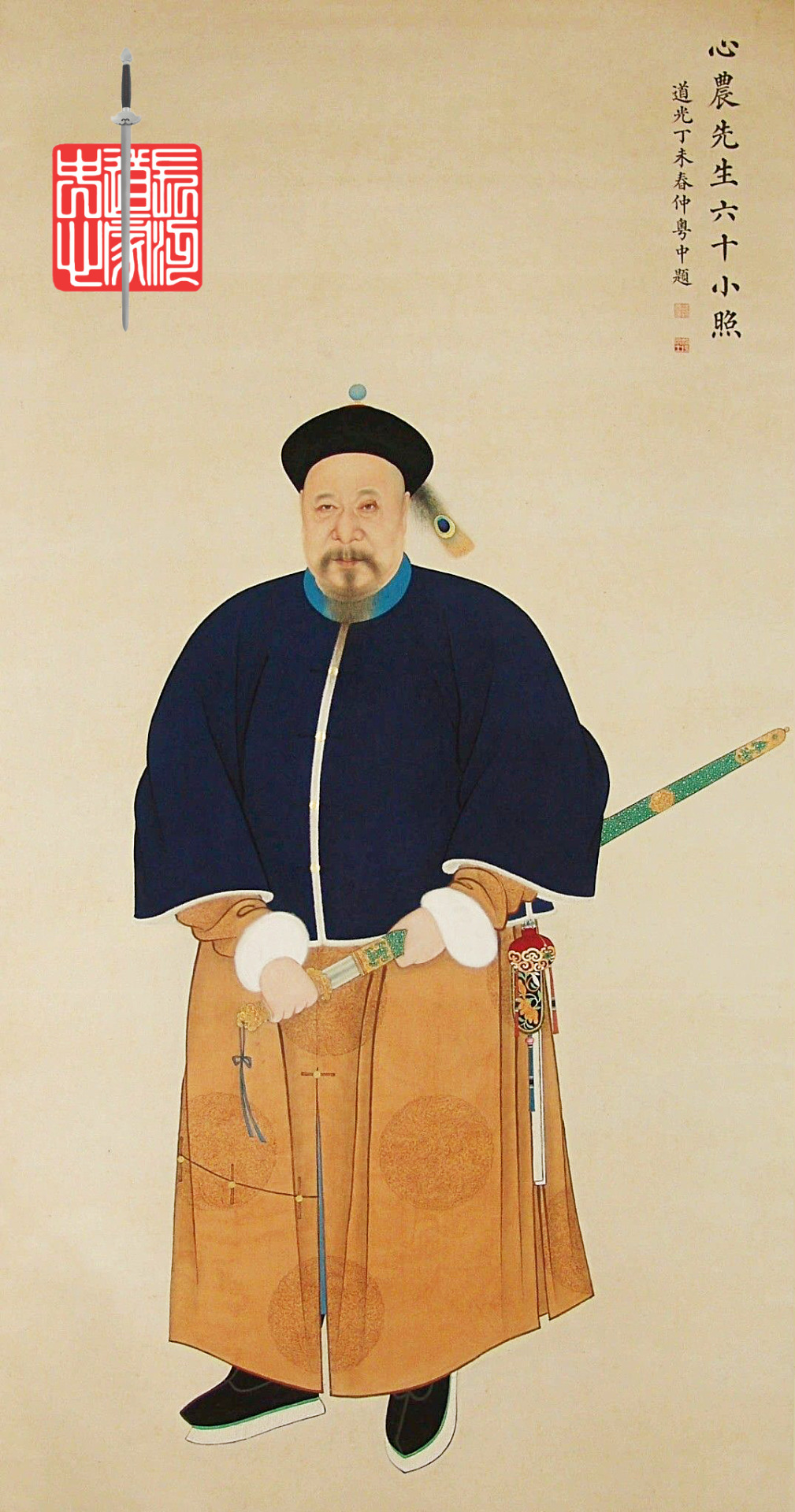

Qing Period images of Bannermen drawing their swords are rare, so I was quite please to uncover this portrait of one unsheathing his Jian.
Comparing what we see here with other Qing Period paintings, we should note several consistent details-
When Drawing a Jian, the left hand typically grasps the scabbard near to, or at, the scabbard throat.
The upward draw into a Liao Cut appears to be the favored draw. This upward Liao can be angled to intercept a cut or initiate an advance.
Jian were often slung from a belt by cloth lanyards, however, it appears that in most cases Jianke preferred to carry the sword in the left free from any restraints a lanyard might impose.
While these details of technique and carry are those commonly depicted, we should also keep in mind that these might have also been a matter of artistic convention of the time.
#chinesemartialart#jianfa#chineseswordsmanship#jianshu#chineseswordfighting#scottmrodell#duanbing#chineseswordplay#swordplay#chinesemartialarts#zhongguojianfa#historicalswordsmanship#swordfightingschool#swordfightingskills#swordfightingclasses#swordfighting#chineseswordwork#swordwork#daoistswordarts#daoistsword#taijijian#taijiswordfencing#taijisword#taichisword#劍術#劍法#中國劍法#太極劍#chineseswordarts#chineseswordart
8 notes
·
View notes
Text
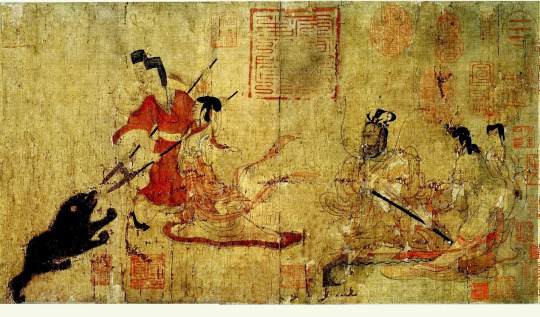


The history of the Chinese Fast Sword Draw (出劍法) dates back to the Han dynasty, 2,000 plus years ago. Unfortunately, there are no known manuals for these techniques and historically illustrations are rare. This depiction of a seated swordsman drawing his sword is from a scroll originally painted by Gu Kaizhi ( 顧愷之) in the 4th century. While Gu’s original version of this scroll, The Admonitions of the Instructress to the Court Ladies (女史箴圖) has not survived, later copies of this work have.
The two following later copies of this scroll date to the Tang (dated between the 6th and 8th century AD) and Song dynasties. As such they are likely the oldest known illustrations of a Chinese Swordsman Preforming the Fast Sword Draw (出劍法). They are also the only know depiction of a seated Chinese sword drawn know to date. Given the age of the two paintings, it is difficult to make out the finer details. What we can see is that seated swordsman’s grip is palm out with his fingers wrapping over the grip prepared to draw and strike downward. His rear hand is well back toward the rear of the scabbard, palm down.
A skeptic might understandable suggest that the seated figure is actually wielding a cudgel. Given the lack of visible detail, this would be an understandable suggestion. However, there is no reason for a wooden club to be gripped at the rear end just prior to swinging it. And given that what appears to be bear is just before the seated man, if it were some sort of cudgel and not a sword ready to be drawn, it is more likely he would be gripping it with two hands not holding the the rear end palm down.
Note: the Tang period example of The Admonitions of the Instructress to the Court Ladies is in the collection of the British Museum in London. The Song period (960-1279) example is the property of the Palace Museum in Beijing.
#出劍法#chineseswordsmanship#jianfa#chineseswordfighting#chineseswordplay#scottmrodell#chinesemartialarts#duanbing#chineseswordsman#chineseswordarts#daoistswordarts#swordfighting#chineseswordfencing#taijiswordfencing#swordfightingskills#kungfuweapons#iaido#scottrodell#testcutting#jianshu#chineseswordart#swordarts#swordsmanship#historicalswordsmanship#swordplay#chinesesword#chineseswords#daofa
8 notes
·
View notes
Photo
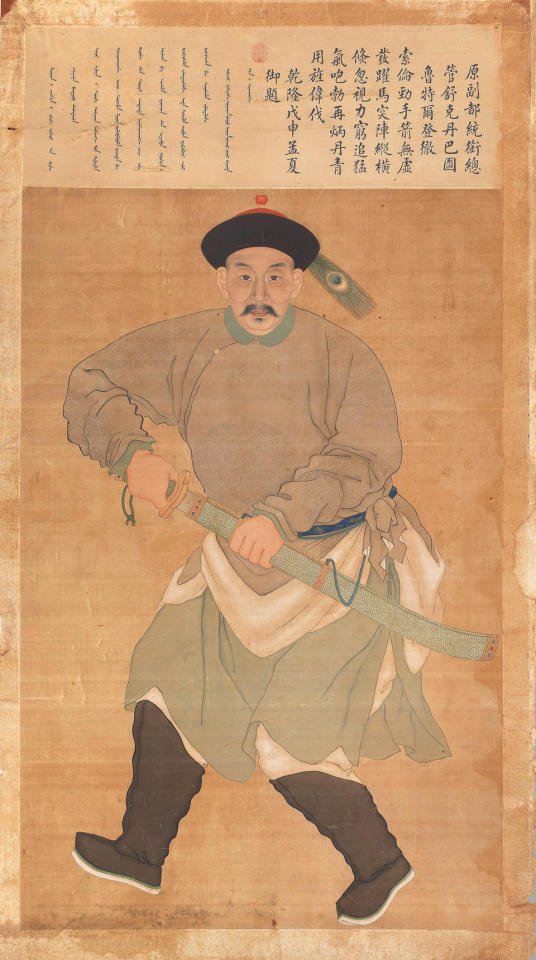
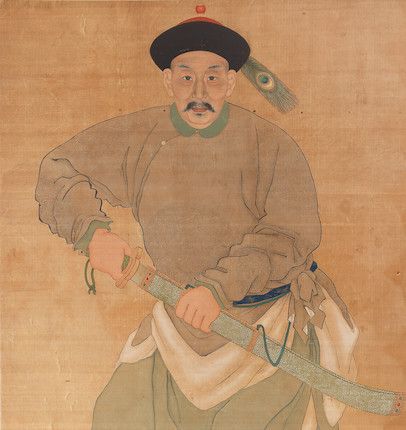
Bannerman Drawing his Saber
What is quite interesting about this painting is how the Sword Drawing technique it depicts is consistent with what we have seen before. Note for example, the position of the hand on the scabbard as he draws. It is not at the scabbard throat, but grasped midway along the suspension band. A detail seen in all other illustrations where a Dao (saber) is being draw. Also note that he is drawing with the edge down. Another apparently standard element of the Chinese Quick Sword Draw.
It is also refreshing to see just how Qing swordsmen dressed. Not in the flamboyant colors often worn by martial artists at tournaments today. But in muted grey, functional and not ostentatious.
For more about this painting of BANNERMAN TE'ER DENG CHE, see Bonham’s Auction Website-
https://www.bonhams.com/auction/27991/lot/128/a-rare-and-important-imperial-court-painting-of-the-bannerman-teer-deng-che-qianlong-dated-by-inscription-to-the-wushen-year-corresponding-to-1788-and-of-the-period/
And for a tutorial on Chinese Fast Sword Drawing, see my video on YouTube-
https://youtu.be/6AVk8PQjh2o
#chineseswordsmanship#chineseswordfighting#chineseswordplay#swordplay#chineseswordwork#swordwork#duanbing#swords#sword#daoistswordarts#chineseswordart#swordarts#swordart#taijiswordfencing#chinesemartialarts#chinesemartialart#swordfighter#swordtraining#swordfightingschool#swordfightingskills#中國刀法#刀法#kungfuweapons#出手法
9 notes
·
View notes
Text
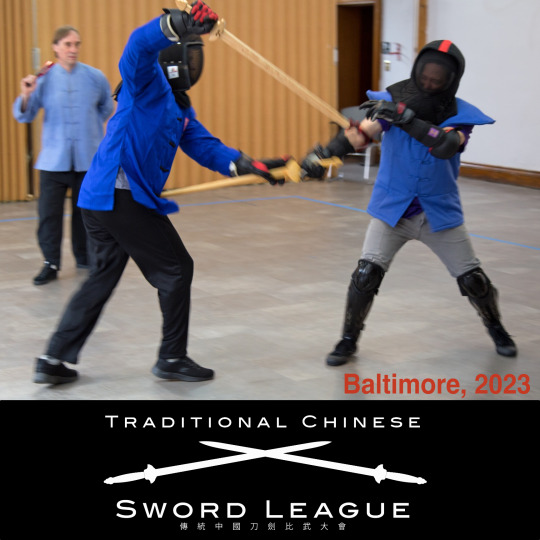
Full Contact Chinese Swordplay Tournament Baltimore, 2023
No reason why you can’t close and use your empty hand to control your Duifang’s weapon.
A solid blow to the head or worse counts as a “killing blow” and ends the bout.
#jianfa#chineseswordsmanship#chineseswordfighting#chineseswordplay#duanbing#chinesemartialarts#chinesemartialart#swordplay#zhongguojianfa#ukchineseswordfighting#swordsmanship#historicalswordsmanship#swordfightingschool#swordfightingskills#swordfightingclasses#swordfighting#swordwork#chineseswordwork
5 notes
·
View notes
Text

We Need Your Input!
Hey everyone! We're reaching out to our current and potential students about Chinese swordsmanship. We want to make our classes and resources better for you.
What's Stopping You?
What are the main obstacles or issues you're facing in learning Chinese swordsmanship? Is it finding time, understanding the techniques, or something else? Let us know in the comments.
Your Feedback Matters
Your feedback is crucial. It helps us understand what you need and how we can improve. So, please, take a moment to tell us about your challenges.
Join the Conversation
If you haven't joined us yet, this is your chance to be part of a community that's all about learning and growing in Chinese swordsmanship. We're here to help each other. Join the Practical Chinese Swordsmanship Facebook group: https://www.facebook.com/groups/chineseswordacademy
Thanks for helping us make the Academy of Chinese Swordsmanship the best place to learn and practice this art.
#chineseswordfighting#chineseswordsmanship#jianfa#duanbing#chinesemartialarts#chineseswordplay#jianshu#scottmrodell#chinesemartialart#chineseswordarts#daoistswordarts#daoistswordsman#swordfightingschool#swordfightingskills#swordfightingclasses#scottrodell#ukchineseswordfighting#chineseswordwork#taijijian#taijiswordfencing#taijisword#taichisword#wudangsword#wudangjian#楊家秘傳太極劍#kungfuweapons#yangstyletaichichuan#yangstyletaichi#太極劍#taijifencing
3 notes
·
View notes
Text
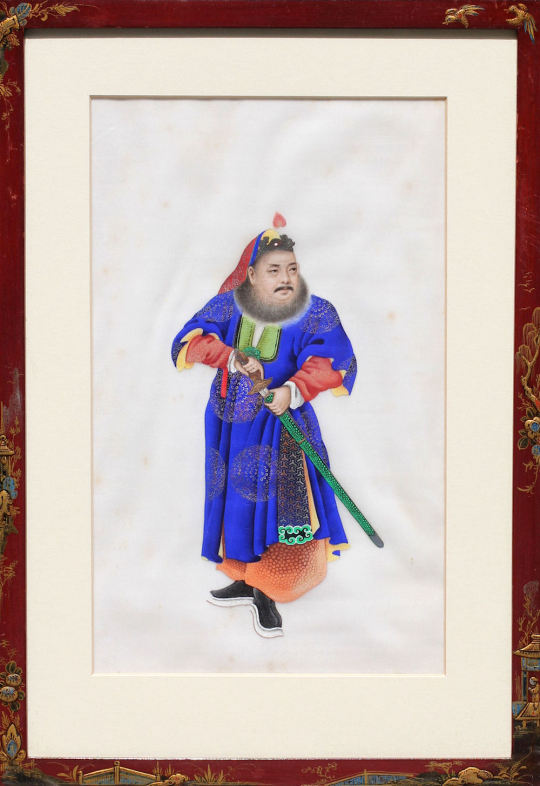
19th Pith Painting of a Jianke in Archaic Clothing
Drawing his Sword-
Another example of a Jianke (swordsman) drawing his jian. As we’ve seen in several other period images, his left hand is positioned at the throat of the scabbard as he draws for a downward cut. These pith paintings were produced in large numbers, this is not a page from a sword manual. So we should be cautious about drawing too many conclusions from it. It is interesting however to note that in multiple period images where a jian is being drawn, the left hand is showed at the top of the scabbard. Drawing of the dao are sometimes also depicted in this fashion, but more often with the left hand further down the scabbard at the suspension band.
I am also pleased to see the shape of the guard is quite similar to my Cutting Jian Hanwei forges.
#chineseswordsmanship#jianfa#chineseswordfighting#chineseswordplay#jianshu#chinesemartialarts#duanbing#chinesemartialart#zhongguojianfa#historicalswordsmanship#swordfightingschool#swordfightingskills#swordfightingclasses#swordfighting#chineseswordwork#swordwork#chineseswordarts#daoistswordarts#taijijian#taijiswordfencing#taijisword#taichisword#wudangjian#wudangsword#swordclasses#中國劍法#chinesefastdraw#劍法#swordfighter#太極劍
3 notes
·
View notes
Text
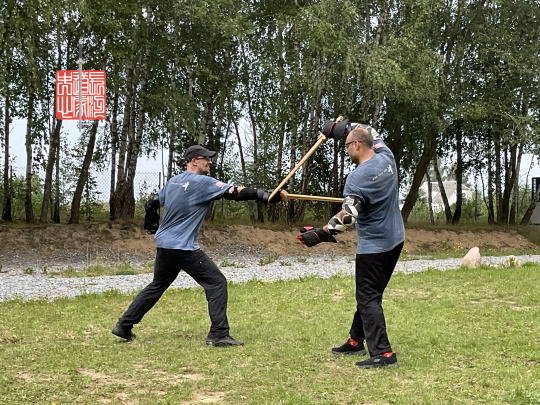
A well timed, perfectly placed Ge Cut delivered by Roland Tepp on the right that intercepts his duifangs cut. Ge Cuts are properly aimed at the sword arm or hand and not the blade. Striking the duifang’s blade often has little result or can even giving the duifang energy to counter-cut with.
Roland Tepp is a long time Apprentice Student at the Academy and runs the Tallinn Branch of the Great River Taoist Center where he teaches.
#jianfa#chineseswordfighting#chineseswordplay#chineseswordsmanship#chinesemartialarts#jianshu#duanbing#chinesemartialart#swordplay#scottmrodell#daoistsword#zhongguojianfa#ukchineseswordfighting#swordsmanship#historicalswordsmanship#swordfightingschool#swordfightingskills#swordfightingclasses#swordfighting#chineseswordwork#swordwork#chineseswordarts#daoistswordarts#taijifencing
4 notes
·
View notes
Text

Republican era artwork -- Shi Jin deflects a flying rope dart.
#rope dart#chineseswordsmanship#chineseswordfighting#chineseswordplay#chinesemartialarts#duanbing#swordplay#chinesemartialart#swordfight#swordfightingskills#swordfightingclasses#swordfighting#swordfightingschool#daofa#chinesesaber#chinesesword#chineseswordarts#kungfuweapons#qingdynasty#flyingdart#chineseswordfencing
4 notes
·
View notes
Text

Love my Jian, but sometimes you just gotta Miaodao…
#chineseswordsmanship#chineseswordfighting#chineseswordplay#chinesemartialarts#duanbing#swordplay#chinesemartialart#scottmrodell#miaodao#scottrodell#swordsmanship#historicalswordsmanship#swordfightingschool#swordfightingskills#swordfightingclasses#swordfighting#chineseswordwork#swordwork#daoistswordsman#swordfighter#dandaofaxuan#dandao#chineselongsword#刀法#中國刀法#daofa#苗刀
2 notes
·
View notes
Text

“In the midst of chaos, there is also opportunity”
INSTANT ACCESS. ANYWHERE. ANYTIME.
Sign up for our FREE 7 DAY TRIAL.
Find a study path that’s right for you..
#chineseswordsmanship#jianfa#chineseswordfighting#chineseswordplay#chinesemartialarts#scottmrodell#duanbing#jianshu#scottrodell#daoistswordarts#swordclasses#swordfightingschool#swordfighter#swordfightingskills#chineseswordarts#swordarts#taijijian#taijiswordfencing#taijisword#taichisword#chinesesword#chineseswordfencing#kungfuweapons#swordplay#yangjiamichuantaijijian#yangstylestaijiquan#yangstyletaichichuan#yangstyletaichi#ukchineseswordfighting#historicalswordsmanship
2 notes
·
View notes
Text

Chinese Sword Fighting. Like speed chess.... but with SWORDS!
INSTANT ACCESS. ANYWHERE. ANYTIME. Sign up for our FREE 7 DAY TRIAL.
Find a study path that’s right for you..
#chineseswordfighting#jianfa#chineseswordsmanship#chineseswordplay#scottmrodell#chinesemartialarts#jianshu#duanbing#scottrodell#yangjiamichuantaijijian#taijijian#taichisword#daoistswordarts#chineseswords#chineseswordarts#swordfightingclasses#swordfightingschool#swordfightingskills#swordclasses#kungfuweapons#taijiswordfencing#chineseswordfencing#ukchineseswordfighting#historicalswordsmanship#wudangsword#wudangjian#swordtraining#劍法#楊家秘傳太極劍#yangstyletaichi
2 notes
·
View notes
Text
Commonly translated as:
"When the world is at peace, the gentleman keeps his sword by his side.” (君子当安平之世,刀剑不离身)
I translated this line from He’s commentary on Sunzi more literally as:
“A gentleman should live peacefully, but his sword should never leave his body.”

#jianfa#chineseswordsmanship#jianshu#chineseswordfighting#chineseswordplay#scottmrodell#swordplay#duanbing#chinesemartialarts#chinesemartialart#chineseswordarts#chineseswordart#swordarts#swordfighting#swordfightingschool#swordfightingskills#swordfightingclasses#swordclasses#swordclass#swordart#chinesesword#chineseswords#swordfigting
3 notes
·
View notes
Text
During the Qing period, the dao (Chinese Saber) was most commonly slung from the waist with the hilt facing back. When work with a bow holster, this placed the hilt out of way and within easy reach. Drawing the dao from this position is easy enough when standing, but seem problematic when seated. As seen here, where a Daoke is getting a pedicure. If he rotated the hilt forward to draw in what is believed was the standard method, he would very likely be impeded by the bench he is seated on.
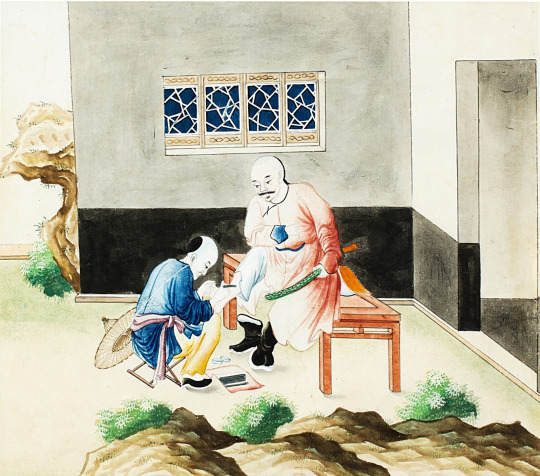
Perhaps this potential obstacle to the sword draw was negated by quickly standing. Whatever was the case, there is still clearly a great deal about the details for Chinese Sword Drawing that remains unknown.
#chineseswordsmanship#chineseswordfighting#chineseswordplay#scottmrodell#swordplay#duanbing#chinesemartialarts#chinesemartialart#sworddrawing#sworddrawingtechnique#daofa#chineseswordwork#chineseswordarts#chineseswordart#swordarts#kungfuweapons#swordfightingschool#swordfightingskills#chineseswords#chineseswordfencing#kungfu#gongfu#qingdynasty#swordfighter#swordfighting
4 notes
·
View notes
Photo
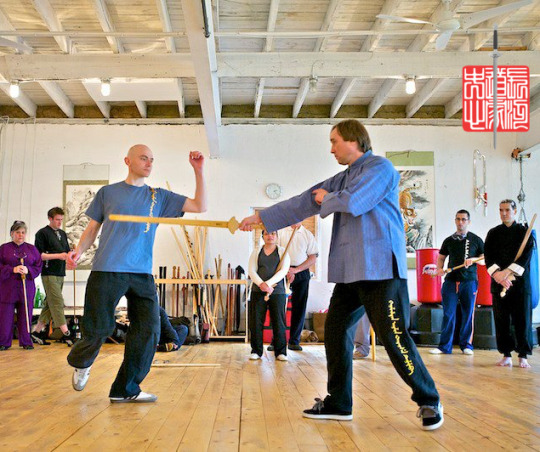
Willow Bends, one of our Basic Core Exercises in Chinese Swordsmanship (Jianfa) In this exercise, one student has his or her sword while the other does not. This helps students to quickly get a sense of distance and timing, as well as learning to stay calm in the face of incoming cuts.
https://www.chineseswordacademy.com/
#zhongguojianfa#jianfa#jianshu#scottmrodel#scottrodell#chineseswordsmanship#historicalswordsmanship#swordsmanship#chineseswordfighting#swordfightingschool#swordfightingskills#swordfighting#chineseswordplay#swordplay#duanbing#chineseswordwork#swordwork#swords#daoistswordarts#chineseswordart#swordart#chineseswordarts#daositswordarts#swordarts#daoistswordsman#taijiswordfencing#yangjiamichuantaijijian#taijijian#taijisword#taichisword
4 notes
·
View notes